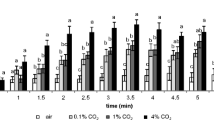Abstract
Carbon dioxide is generally recognized as an important cue used by haematophagous insects to locate a food source. When the mammalian hosts of these insects breathe, they normally emanate considerable amounts of CO2 at discrete intervals, i.e. with each exhalation. In this work, we analysed the effect of temporally pulsing CO2 on the host-seeking behaviour of Triatoma infestans. We investigated the ability of T. infestans to follow continuous and intermittent air pulses of 0.25, 0.5 and 1 Hz that included different concentrations of CO2. We found that insects were attracted to pulsed airstreams of 0.25 and 0.5 Hz transporting 400 ppm of CO2 above the ambient levels and to continuous streams added with the same amount of CO2. On the other hand, insects walked away from streams pulsed at rates of 1 Hz regardless of the amount of CO2 they bear. The walking trajectories displayed by bugs to attractive CO2-pulsed streams were as rectilinear and accurate as those to CO2-continuous streams. Our results are discussed in the frame of the interaction between olfactory and mechanoreceptive inputs as affecting the behavioural response of bugs.

Similar content being viewed by others
References
Baker TC, Willis MA, Haynes KF, Phelan PL (1985) A pulsed cloud of sex pheromone elicits upwind flight in male moths. Physiol Entomol 10:257–265
Barrozo RB, Lazzari CR (2004a) The response of the blood-sucking bug Triatoma infestans to carbon dioxide and other host odours. Chem Senses 29:319–329
Barrozo RB, Lazzari CR (2004b) Orientation behaviour of the blood-sucking bug Triatoma infestans to short-chain fatty acids: synergistic effect of l-lactic acid and carbon dioxide. Chem Senses 29:833–841
Barrozo RB, Manrique G, Lazzari CR (2003) The role of water vapour in the orientation behaviour of the blood-sucking bug Triatoma infestans (Hemiptera, Reduviidae). J Insect Physiol 49:315–321
Barrozo RB, Minoli SA, Lazzari CR (2004) Circadian rhythm of behavioural responsiveness to carbon dioxide in the blood-sucking bug Triatoma infestans (Heteroptera: Reduviidae). J Insect Physiol 50:249–254
Batschelet E (1981) Circular statistics in biology. Academic Press, London
Dekker T, Takken W, Carde RT (2001) Structure of host-odour plumes influences catch of Anopheles gambiae s.s. and Aedes aegypti in a dual-choice olfactometer. Physiol Entomol 26:124–134
Frame GW, Strauss WG, Maibach HI (1972) Carbon dioxide emission of the human arm and hand. J Invest Dermatol 59:344–440
Geier M, Bosch OJ, Boeckh J (1999) Influence of odour plume structure on upwind flight of mosquitoes towards hosts. J Exp Biol 202:1639–1648
Gillies MT (1980) The role of carbon dioxide in host-finding by mosquitoes (Diptera: Culicidae): a review. Bull Entomol Res 70:525–532
Guerenstein PG, Guerin PM (2001) Olfactory and behavioural responses of the blood-sucking bug Triatoma infestans to odours of vertebrate hosts. J Exp Biol 204:585–597
Gürtler RE, Cohen JE, Cecere MC, Chuit R (1997) Shifting host choices of the vector of Chagas disease, in houses in north-west Argentina. J Appl Ecol 34:699–715
Kaissling K-E (1997) Pheromone-controlled anemotaxis in moths. In: Lehrer M (ed) Orientation and communication in arthropods. Birkhaeuser, Basel, pp 343–374
Kramer E (1986) Turbulent diffusion and pheromone-triggered anemotaxis. In: Payne TL, Birch MC, Kennedy CEJ (eds) Mechanisms in insect olfaction. Clarendon Press, Oxford, pp 59–67
Lazzari CR, Núñez JA (1989) The response to radiant heat and the estimation of the temperature of distant sources in Triatoma infestans. J Insect Physiol 35:525–529
Lehane MJ (2005) The biology of blood-sucking insects. Cambridge University Press, Cambridge
Mafra-Neto A, Cardé RT (1994) Fine-scale structure of pheromone plumes modulates upwind orientation of flying moths. Nature 369:142–144
Mafra-Neto A, Cardé RT (1996) Dissection of pheromone-modulated flight of moths using single-pulsed response as a template. Experientia 52:373–379
Núñez JA (1987) Behaviour of Triatominae bugs. In: Brenner RR, Stoka AM (eds) Chagas’ disease vectors, vol II. Anatomic and physiological aspects. CRC Press, Boca Raton, pp 1–30
Reisenman CE, Lazzari CR, Giurfa M (1998) Circadian control of photonegative sensitivity in the haematophagous bug Triatoma infestans. J Comp Physiol A 183:533–541
WHO (2000) (World Health Organization) Weekly epidemiological record. Geneva
Zar JH (1984) Biostatistical analysis. Prentice-Hall, Englewood Cliffs
Acknowledgements
The authors are deeply indebted to M. Greenfield, K.-E. Kaissling and to S. A. Minoli for critically reading of the manuscript. We also sincerely thank D. Anfossi for designing the software used for recording data from the locomotion compensator. This investigation received financial support from the Universidad de Buenos Aires, CONICET (Argentina) and from the UNDP/World Bank/WHO Special Programme for Research and Training in Tropical Diseases (TDR). The experiments were conducted in accordance with the highest standards of animal care as outlined in the “Guide for the Care and Use of Laboratory Animals” published in 1996 by the National Institute of Health.
Author information
Authors and Affiliations
Corresponding author
Rights and permissions
About this article
Cite this article
Barrozo, R.B., Lazzari, C.R. Orientation response of haematophagous bugs to CO2: the effect of the temporal structure of the stimulus. J Comp Physiol A 192, 827–831 (2006). https://doi.org/10.1007/s00359-006-0120-y
Received:
Revised:
Accepted:
Published:
Issue Date:
DOI: https://doi.org/10.1007/s00359-006-0120-y




